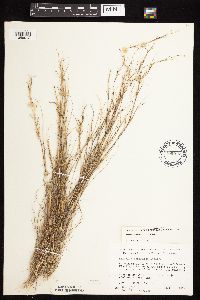Aristida basiramea
|
|
|
|
Family: Poaceae
Forked Three-Awn, more...Aristide à Rameaux Basilaires, Forktip Threeawn
|
Plants annual. Culms 25-45 cm, erect, branching at most nodes. Leaves cauline; sheaths shorter than the internodes, glabrous or sparsely pilose; ligules about 0.3 mm; blades 3-8 cm long, 1-1.5 mm wide, flat to folded, becoming involute in age, adaxial surfaces with scattered pilose hairs, pale green. Inflorescences racemose or paniculate, (2)4-10 cm long, 1-2 cm wide, with few (sometimes only 1 or 2) spikelets; primary branches weakly developed, to 2 cm, appressed, with 1-3 spikelets. Spikelets appressed, only slightly overlapping. Glumes 1-veined, acute, awned, awns 1-2 mm, brown to purplish; upper glumes 10-12 mm; lower glumes 1-2 mm shorter; calluses 0.4-0.6 mm; lemmas 8-9 mm, light gray, mottled; awns erect to divergent; central awns 10-15 mm, with 2-3 spiral coils at the base; lateral awns 5-10 mm, not coiled but often curved and twisted basally, strongly divergent distally; anthers 3, about 3 mm, purplish-brown. Caryopses 6-7 mm, light chestnut brown. 2n = unknown. Aristida basiramea grows in open, sandy, often barren ground in southern Ontario and in the United States. It is similar to A. dichotoma, differing in its longer lateral awns. Further study may show that the two should be treated as conspecific varieties. Annual herb 25 cm - 0.55 m tall Leaves: borne along the culm, with open, hairless or sparsely soft-haired sheaths shorter than the internodes and ligules made of hairs about 0.3 mm long. The blades are pale green, 3 - 8 cm long, 1 - 1.5 mm wide, flat or folded, sparsely hairy above, with the margins rolling toward the upper surface of the midvein (involute) when old. Inflorescence: terminal, 2 - 10 cm long, 1 - 2 cm wide, sometimes branched, with primary branches to 2 cm long. Fruit: a light brown caryopsis, 6 - 7 mm long, spindle-shaped, with a linear scar. Culm: erect, 25 - 45 cm long, branching at the nodes. Spikelets: one to three per branch, appressed, slightly overlapping. Glumes: brown to purplish, thin, single-veined, with a pointed tip ending in awn 1 - 2 mm long. The upper glume is 10 - 12 mm long and the lower glume is 8 - 11 mm long. Florets: one per spikelet, with three purplish brown anthers about 3 mm long. Lemma: mottled light gray, 8 - 9 mm long, spindle-shaped, rolled up longitudinally (convolute), three-veined, and three-awned. The terminal awn is 10 - 15 mm long with two or three spiral coils at the base, and lateral awns are 5 - 10 mm long and curved or twisted near the base. Palea: two-veined, shorter than the lemmas. Similar species: Aristida tuberculosa is easily distinguished because its awns are twisted into an 8 - 15 mm column that separates into three straight awns at the top. Awns of Aristida oligantha are not twisted at the base and reach up to 7 cm in length. Aristida dichotoma has a 3 - 8 mm long central awn that is twisted at the base and 1 - 4 mm long lateral awns, while Aristida longispica has a 1 - 27 mm long central awn that is curved at the base and lateral awns (if present) reaching 18 mm long. Awns of Aristida purpurascens are curved to arching or twisted at the base with the lateral awns about as long as the central one (8 - 25 mm long). Flowering: August to October Habitat and ecology: Probably introduced from the western United States, this species grows along railroads or sandy soil. Occurence in the Chicago region: non-native Etymology: Aristida comes from the Latin word arista, meaning awn. Basiramea means "branching from the base." Author: The Morton Arboretum Erect, tufted annual 3-6 dm; lvs very narrow, ca 1 mm wide, often involute; panicles slender, the terminal one 5-10 cm, rather loose, the lateral shorter and more slender, scarcely surpassing the subtending sheaths; glumes 1-veined, distinctly unequal; lemma usually about equaling the first glume; central awn divergent, coiled at base when dry into one-half to 3 complete turns; lateral awns erect to curved-divergent but not coiled. Dry, often sandy soil; Mich. to Minn. and Wyo., s. to Ill., Ark., Okla., and Colo., and casually e. to Me., Pa., Va., and Fla. Two vars. with nearly coextensive range. Gleason, Henry A. & Cronquist, Arthur J. 1991. Manual of vascular plants of northeastern United States and adjacent Canada. lxxv + 910 pp. ©The New York Botanical Garden. All rights reserved. Used by permission. From Flora of Indiana (1940) by Charles C. Deam Indiana Coefficient of Conservatism: C = null, non-native Wetland Indicator Status: n/a |



































































































